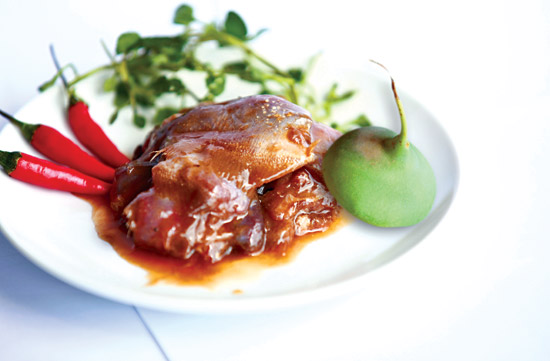(No.2, Vol.3, Mar 2013 Vietnam Heritage Magazine)
In his dictionary of southern Vietnamese, scholar Vuong Hong Sen writes, “Mangrove apple trees have beautiful green leaves. At night, the sight of many fireflies perched upon them is quite lovely. The trees bear fruit, which tastes delicious eaten with fresh salted fish. When King Nguyen Anh tasted it, he was quite satisfied and dubbed it with the literary name ‘Thuy Lieu’ (Water Willow).” Throughout the ages, it has not always been the case that when a king finds a dish delicious, the common people do so as well. However, salted gourami with sour mangrove apple was particularly favoured by both the king and the people. Moreover, modern researches show that mangrove apples are very good for one’s health.

A sour mangrove apple (right), salted fish, chilli and herbs. Photo: Le Hong Thai
The mangrove apple tree has the scientific name Sonneratiacaseolaris (L.) Engl. (S.acidaL.f.) and belongs to the Sonneratiaceae family. It is a kind of tree that grows in salt-marsh forests along the coasts of Vietnam. The mangrove apple tree grows primarily in brackish regions along littoral riverbanks where the tides rise and fall. Its leaves are oval. The mangrove apple tree blooms after the dry season just before the rainy season. The parts that are commonly used to make foods are the leaves and fruits. Two prevalent types of the fruit in Vietnam are the saucer mangrove apple (Sonneratiacaseolaris) and the guava mangrove apple (Sonneratiagiffithii). Saucer mangrove apples grow along riverbanks, on islands, and at river ramifications, etc. Its fruits are large and round like a saucer, hence its name. As for the guava mangrove apple tree, it is planted near homes to expedite picking its fruit, which is eaten seasonally. This fruit is many times smaller than the saucer mangrove apple.
In terms of chemical composition, mangrove apples contain the colour agents archin (emodin) and archicin (chrysophanic acid), which have anti-oxidizing, laxative, and detoxifying effects. They also strengthen blood vessels, remedy stomach ulcers, reduce absorption of sugars and fat, and reduce blood pressure. According to traditional oriental medicine, the mangrove apple has cooling properties, quells inflammation, and reduces pain. The leaves have an acrid taste and styptic properties. In India, people use the fruit juices by fermenting them to create a medicine that inhibits bleeding. In Malaysia, people bray the leaves with rice to make medicine that remedies urine retention and kills intestinal parasites. They eat ripe mangrove apples to treat coughing. In Myanmar, people use mangrove apples by grinding them into an adhesive plaster or glutinous paste, which are then mixed with salt and applied to insect bites, while for congested bruises they ferment the fruit juice as a haemostatic. In Vietnam, common folk often grind the leaves, add salt, and make a commonly used medicine that is applied to bruises and minor injuries.
Although the mangrove apple may seem a bit plebeian, it is an ingredient that is made into many countryside specialty dishes: mangrove apple sour soup, mangrove apple shoots fried with field mice, ripe mangrove apples braised with fish, mangrove apples and fish hotpot, and mangrove apple jam, etc. The simplest is to pick mangrove apples and dip them in salt as a snack. They can be sliced into thin pieces and combined with boiled meats, or eaten with different garden vegetables like cynometra sprouts, mango sprouts, turmeric sprouts, gooseberry leaves, and pepper elder. However, perhaps the most frequently- mentioned dish of all is sour mangrove apple eaten with salted gourami. An interesting folk song says, “If you want to eat salted gourami with sour mangrove apple, just wait until the flood season to feast and sate your craving.”
Among the various kinds of salted fresh fish, especially freshwater salted fish, salted gourami is eaten quite simply; you just take some out of its earthenware jar or pot and you can eat it right away. Gouramis are also not too large like anabas or snakeheads, so they are perfectly bite-sized. Just open up the salted gourami, cut some tart bananas, put in a bit of wild vegetables like creek premna as well as cold rice, creeping fig, cynometra, and green Tabasco peppers, add in a mangrove apple, and finally, eat it with piping hot rice for an indulgent delicacy. Guava mangrove apples and saucer mangrove apples are both delectable when eaten with salted gourami. Connoisseurs, being a bit finicky, select mangrove apples that are not too ripe, just as they become tart, and are perfectly crisp and nutty; since when mangrove apple seeds are crunched in the teeth, the acridity of the seeds mixes with the salted gourami with an uncanny appeal.
As for nutrition, salted fish in general and salted gourami in particular stimulate digestion, facilitate the palate, and promote hearty eating. Salted fish contain amino acids, a small amount of lipids and minerals, and a lot of salt, so people with high blood pressure, heart conditions, liver or kidney failure, and diabetes need to limit their consumption. Some researchers have shown that the nitric content in salted fish is quite high. When it enters the stomach, not only does it cause antioxidant loss, but it will react with other substances to increase cancer risk. Nevertheless, you should not be overly concerned, since such risk only occurs when you constantly eat salted fish in copious amounts. However, if you only eat salted fish once or twice a week in small quantities, just enough to sate your craving, and when you include lots of green vegetables, as is especially the case with the dish “salted gourami with sour mangrove apple,” then not only will it taste delicious, but it will also be salubrious.
The article was published on Sai Gon Tiep Thi of August, 2012.

